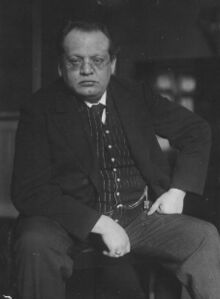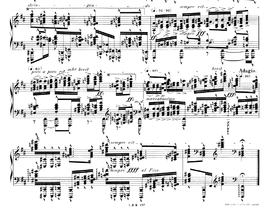Max Reger
Max Reger (19 March 1873 – 11 May 1916) was a German composer and the inventor of musical violence. Musical violence, in this context, means that, rather than expressing violence or requiring physical violence to be used against the instrument (as Franz Liszt is known to have frequently demolished pianos in the attempt to realize his musical concepts before he used to play on Bösendorfer pianos after finding out that they did not break under his playing) or the performer (like the choir part in Ludwig van Beethoven's Missa Solemnis) in order to be produced, the music itself becomes the medium through which violence is exerted, a weapon so to speak, against everyone within its area of reach, performers and listeners alike.
This is not to say, however, that Reger's music doesn't require physical violence to be used against the instrument or the performer. On the contrary, the way Reger achieved musical violence was by composing music of such extreme dynamic dimensions that the resulting sound waves are powerful enough to cause physical harm to exposed humans that is not limited to the ear only, which means that unprecedented force has to be applied to a musical instrument or the vocal folds, oftentimes at the risk, and in some cases even with the aim, of destroying the instrument or a singer's voice. For these reasons, Reger's music is seldom performed, and when it is, it is usually done in a mitigated manner so as to reduce the number of casualties.
Music[edit]
Max Reger was a man of excess. Moderation was a concept either unknown to or simply rejected by him, musically as well as personally. For example, he is known to have ordered "Schnitzel for the next two hours" at a restaurant once, and his alcohol consumption was such that, by the age of 43, he had already consumed enough alcohol for a lifetime, which could also be the reason he died at that age from a heart attack.
Similar to his eating and drinking habits, Reger's music is an epitome of excess. The violence carried out through it is one manifestation thereof, but it is not the only one. Just like the loud passages are crushingly loud, the soft passages in Reger's music are near-unhearable, especially when the ear has already sustained damage from the calamitous force of the loud passages. Indeed, considering the physiological implications of continuously attacking the eardrum with fff or even ffff music, possibly with the additional requirement "marcatissimo", the question arises whether there is, in fact, any point in playing the passages marked pppp at all.
Violence[edit]
While Reger composed many short works such as piano and vocal pieces that are not violent or even excessive at all, most of his longer works are. There are several common characteristics to be found among them in the way Reger achieves violence. One of them is his fanatic use of accents towards the end of a work, especially in his piano works (but not his organ works). One example is his Introduction, Passacaglia and Fugue for 2 pianos, Op. 96. In the last 16 bars, where the dynamic is already fff and each pianist plays 8- or 10-note-chords most of the time (which, with 10 fingers per pianist, is about as many notes as can be played simultaneously while still maintaining control over which keys are pressed), Reger exacerbates the situation by marking every single one of these chords, even the ones that consist of fewer notes, with a marcato sign, in addition to reminding the pianists every three bars to play "sempre fff e marcatissimo", until the last 3 bars, where the dynamic finally reaches ffff after a crescendo in the preceding bar. The piece ends with the cataclysmic destruction of the two pianos signified by a fffz marking on the last chord (within the general dynamic of ffff) on top of the usual marcato sign.
In order to fully savor the impact of such escapades, Reger often combined them with a continuous and highly prolonged ritardando, which is naturally much more effective on the organ or with an orchestra than on the piano because the sound does not fade away after being produced and, while a marcato cannot be realized on the organ, the ratio of increase in total sound power emitted to the amount of ritardando performed is distinctly higher than on the piano. On the other hand, the fading away of the sound on the piano causes the next marcatissimo to sound all the more brutal, and the more time there is for the sound to fade away, the louder the next marcatissimo seems.
The 100th Psalm[edit]

While taking a look at the score is usually enough to tell that the consequences of Reger's music cannot be reasonably ignored even by people who don't care about music at all, there is one known instance where Reger himself admitted to his intention of murdering the audience with his music, and that is his setting of the 100th psalm, Op. 106, which ironically starts with the words "Jauchzet dem Herrn, alle Welt" ("Shout with joy to the Lord, all the world") and ends with "Denn der Herr ist freundlich, und seine Gnade währet ewig und seine Wahrheit für und für" ("For the Lord is kind, and his mercy lasts eternally and his truth forever"). This work is scored for chorus and a large orchestra, and according to Reger, its listeners "must be stuck to the wall like a relief" afterwards and the psalm should have a "devastating effect". To ensure that this would happen, Reger, in addition to his usual, already described tactics, designed a special weapon which he reserved for the final fugue section of the last movement, to be then unleashed as the ultimate climax of the work: an additional ensemble of at least 4 trumpets and 4 tenor trombones playing the melody of the choral "Ein' feste Burg ist unser Gott" over the turmoil of the rest of the orchestra and the chorus. The dynamic indication of this choral is surprisingly only f initially and ff at the end. A possible explanation for this moderation is that Reger wanted to avoid a deus-ex-machina-effect that would inevitably have arisen had the collapse of the concert location been brought about by the sudden advent of 8 or more instruments that had never before appeared in the work making a frighteningly realistic impression of the legendary trumpets that are said to have crumbled the walls of Jericho but, as a consequence, making the rest of the orchestra appear rather unnecessary, which, with the main orchestra already containing two trumpets, three trombones and even a tuba, would be quite a disappointment. Instead, Reger showcases his weapon first by triggering it in alternation with the orchestra's trombones and tuba (with the exception of one short passage where both groups play simultaneously), who repeat the choral lines played by the 8+ external trumpets and trombones and are aided therein by the double basses and a double pedal in the organ, and only in the last 5 and a half bars, when the Allegro Maestoso has gradually turned into an Adagio, does he unite it with all the remaining forces into one gargantuan superforce for the final rampage: Everyone in the main orchestra and the chorus plays/sings fff except for the percussion section, who reach the fff later, and, superimposed on top of that, the external trumpets and trombones play the last choral line, now finally ff, thus obliterating even the most resistant non-believer.
Legacy[edit]
There is no evidence that Max Reger was a sadist and that his musical output was motivated by the desire to deliberately cause pain to other humans. On the contrary, the fact that Reger associated being crushed against a wall with joy and mercy suggests that he was simply a psychopath with a passion for violence and destruction. Nevertheless, the torturous potential of music demonstrated by Reger has been recognized by composers such as Pierre Boulez, who with Le marteau sans maître developed a sophisticated mental torture method that works by depriving the listener of low frequencies for over half an hour whilst emitting a constant stream of thoroughly incoherent harmonies and melodies, thereby subtly driving the listener insane.
The use of music as a torture device has reportedly also been adapted by the CIA, although the torture there lies in the excessive repetition of music and not the music itself.
| |||||


